February 20 - March 6, 2003
Mount Washington, N.H.: A Look Back
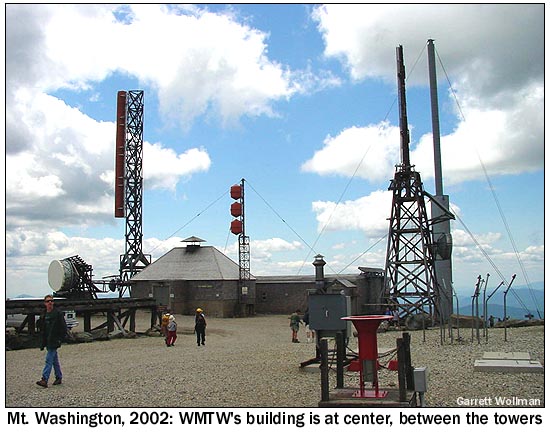 Almost exactly a
year ago - February 6, 2002, to be exact, we presented a Tower
Site of the Week feature on the WMTW-TV transmitter site high
atop Mount Washington, New Hampshire. It was newsworthy then
because WMTW had just signed off from the Rock in favor of a
new site in Baldwin, Maine. Little could we have imagined that
it would become newsworthy again on Sunday, February 9, 2003,
when a fire that apparently began in the exhaust system of the
generators blazed out of control, destroying the WMTW building
and the adjacent Yankee Power House. Almost exactly a
year ago - February 6, 2002, to be exact, we presented a Tower
Site of the Week feature on the WMTW-TV transmitter site high
atop Mount Washington, New Hampshire. It was newsworthy then
because WMTW had just signed off from the Rock in favor of a
new site in Baldwin, Maine. Little could we have imagined that
it would become newsworthy again on Sunday, February 9, 2003,
when a fire that apparently began in the exhaust system of the
generators blazed out of control, destroying the WMTW building
and the adjacent Yankee Power House.
In memory of what was once one of the most impressive broadcast
facilities in the Northeast (and as a way of showing off some
of the nifty pictures that our Boston
Radio Archives co-editor Garrett Wollman took during a rare
blue-sky moment on the mountain last summer), we offer a recap
of that Site of the Week installment, annotated to indicate what
was lost in the fire on February 9.
(And we should mention that Site of the Week is actually Site
of the Every-Other-Week for a few weeks while we're on the road
gathering still more exciting tower images to share with you!)
First, a quick ID of the towers in Garrett's photo, above:
at left is the WHOM 94.9 antenna, its multiple bays enclosed
in a tubular radome. The Yankee Power House is the hip-roofed
building between WHOM's current antenna and its auxiliary antenna,
the three bays on the short tower. (At least the radome on the
bottom bay was damaged in the fire.) The WMTW building itself
is next on the right, hiding behind those weather monitoring
doohickeys. The Armstrong tower that dates back to 1937 is at
right, with the WMTW auxiliary antenna on top (it seems to have
survived the fire without significant damage), with the heavily-radomed
WMTW antenna from the early sixties just behind it.
On with the look back...
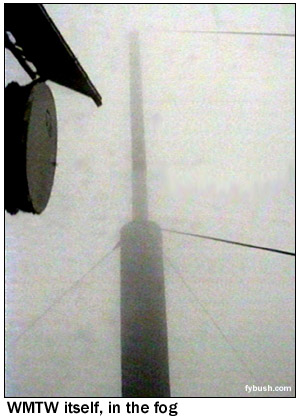 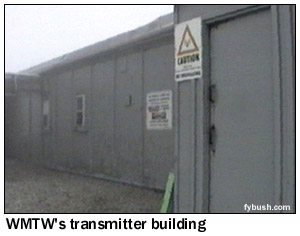 There are few spots as inhospitable
for a broadcast transmitter as the top of Mount Washington, New
Hampshire. There are few spots as inhospitable
for a broadcast transmitter as the top of Mount Washington, New
Hampshire.
The highest point in the northeastern U.S. is renowned as
the home of some of the worst weather in the world, including
a record wind gust of 231 miles per hour and winter temperatures
that routinely hover in the minus-twenties.
But at 6,288 feet above sea level, with a line of sight that
stretches from Portland, Maine to Boston to southern Quebec,
it was also an ideal spot to test the limits of VHF broadcasting
in its earliest days.
In 1940, that meant FM radio - and in 1940, FM radio meant
Edwin H. Armstrong, the inventor of the technology. Working with
John Shepard, the owner of a Boston department store chain, Armstrong
built the first FM network atop two New England peaks: Mount
Asnebumskit in Paxton, near Worcester, Mass. and Mount Washington
itself.
W1XER was the initial call for the station on Mount Washington's
rocky crown, which actually began as a high-frequency AM station
in 1937, operating on 42.3 megacycles. In the summer of 1940,
Armstrong converted the station to FM operation, using the call
W39B and the frequency of 43.9 mc when full-time operation began
that December. The original antenna was made of eight truck springs,
designed to bear the weight of the winter ice buildup on the
mountain and spring back to shape once the ice melted in the
spring!
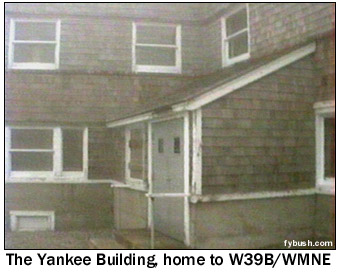 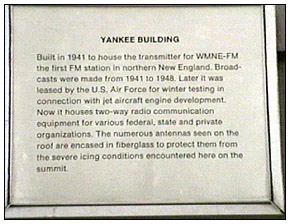 Two buildings atop
the mountain housed the station, which was officially licensed
to Boston, 150 miles distant. Two buildings atop
the mountain housed the station, which was officially licensed
to Boston, 150 miles distant.
Shown at the left is the "Yankee Building" that
housed the transmitter and studio facilities (though much of
the programming originated at Yankee studios in Boston, relayed
to the Asnebumskit transmitter and then picked up at Washington
for rebroadcast); a short distance away is the Yankee powerhouse
where the electricity needed for the broadcasts was generated.
There has never been a power line running up the mountain from
the valley below, and the broadcasters of Mount Washington have
long borne the responsibility of providing power for the Mount
Washington Observatory as well as their own needs.
(The Yankee Building, which sits between the WMTW complex
and the Sherman Adams Building that houses the Mount Washington
Observatory, survived the fire intact.)
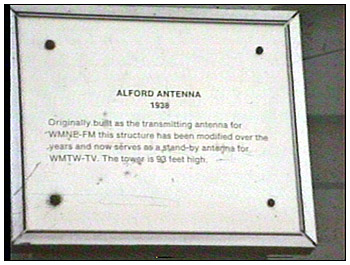  W39B (known later
as WMTW-FM on 98.5 and still later as WMNE on 100.5, by then
licensed to Portland instead of Boston) used a 90-foot tower
next to the Yankee Building, with a series of antennas that started
with the famous "spring" antenna and were continually
modified as the station changed frequency over the years. W39B (known later
as WMTW-FM on 98.5 and still later as WMNE on 100.5, by then
licensed to Portland instead of Boston) used a 90-foot tower
next to the Yankee Building, with a series of antennas that started
with the famous "spring" antenna and were continually
modified as the station changed frequency over the years.
The tower still stands, and we'll see it in a moment - but
first, let's close a chapter in the mountain's history.
"The Rock" went silent on December 31, 1948, when
the Yankee Network (by then owned by General Tire) decided the
wide reach of the Mount Washington signal was outweighed by the
very limited FM audience and the high cost of maintaining a year-round
staff on a mountaintop that was inaccessible for days at a time
in winter. (Then as now, engineers rotated on and off the mountain
in one- or two-week shifts, getting up and down on snowmobiles.)
In the spring of 1954, Mount Washington became a busy place
again; this time preparing for the arrival of television. A building
and transmitter were fabricated in Manchester, then trucked north
to be reassembled between the old Yankee Building and the powerhouse.
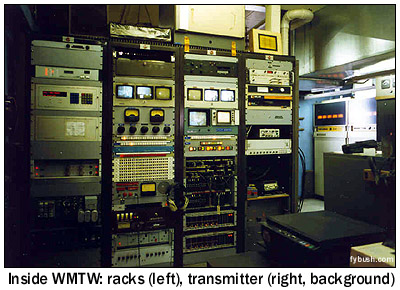 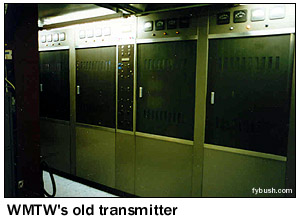 On
September 25, 1954, WMTW-TV, licensed to Poland Spring, Maine,
signed on from studios in the historic Riccar Inn and the new
105,000-watt transmission facility high atop Mount Washington. On
September 25, 1954, WMTW-TV, licensed to Poland Spring, Maine,
signed on from studios in the historic Riccar Inn and the new
105,000-watt transmission facility high atop Mount Washington.
Programming was transmitted by microwave over the 46 miles
between the two locations.
The signal from the Alford antenna atop the old Armstrong
tower reached a huge swath of Maine, New Hampshire, Vermont,
New York and Quebec - in many cases, areas that had never had
a clear television signal until then.
In the sixties, WMTW upgraded its mountaintop facilities,
building a new RCA antenna and tower completely enclosed in a
cylindrical radome to replace the old Armstrong tower and Alford
antenna, which remained available as a standby. In the seventies,
a new RCA transmitter (just visible at rear in the above photo)
supplanted the old TT-25 transmitter.
(The old transmitters disappeared from the mountain sometime
before WMTW left completely; in pictures we've seen from channel
8's last few years there - you can see them too at www.mountwashington.com
- the old RCA transmitters had been replaced by a new solid-state
transmitter, which looked kind of lonely in that big room. And
even that transmitter was gone by the end of summer 2002, when
WMTW vacated the premises, leaving the building occupied only
by WHOM 94.9 and the generators, operated now by the state of
New Hampshire.)
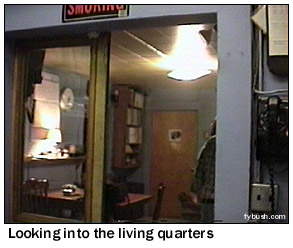 The
engineers who maintained the transmitter even became stars, in
a way; WMTW's newscasts featured live weather reports from the
mountaintop all winter long, delivered for many years by Marty
Angstrom, whose Maine accent became a hallmark of channel 8's
programming. The
engineers who maintained the transmitter even became stars, in
a way; WMTW's newscasts featured live weather reports from the
mountaintop all winter long, delivered for many years by Marty
Angstrom, whose Maine accent became a hallmark of channel 8's
programming.
The transmitter building houses full living facilities, including
two huge freezers to store a winter's worth of food, brought
up each July and August to be eaten over the next ten months
or so.
We were fortunate to meet Marty and the rest of the crew at
WMTW when we visited The Rock in June of 1995 to take these pictures.
It was a warm, sunny day as we approached the base of the Mount
Washington Auto Road; by the time we reached the summit, it was
in the forties and fog was rolling in.
By the time we left the transmitter building, the fog had
surrounded the mountaintop, which is why you don't get to see
as much of these towers as we'd hoped to present.
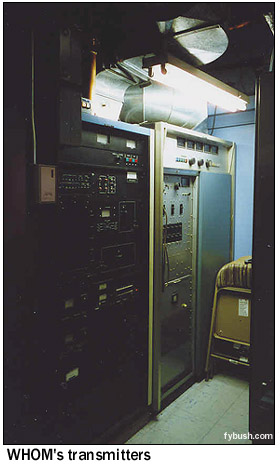 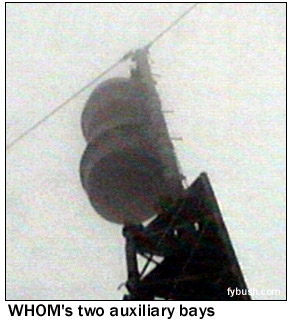 WMTW,
of course, was hardly alone on the mountaintop by the time we
got there. WMTW,
of course, was hardly alone on the mountaintop by the time we
got there.
In 1958, WMTW added FM service to its TV facility, resurrecting
the old WMTW-FM calls for a 48 kW facility on 94.9 MHz, licensed
to "Mount Washington" itself.
Originally located on a two-bay antenna on a tower next to
the TV transmitter building, WMTW-FM later moved to a new multi-bay
antenna (completely enclosed in a cylindrical radome) alongside
the power house. Sold off from the TV station in the seventies,
94.9 went through a few years as WMTQ before becoming WHOM, operating
from studios in Portland and a transmitter (seen at left) in
the WMTW-TV building, maintained all winter long by the channel
8 technicians.
A third station joined the crowd on the mountain in the eighties,
when WMOU-FM (103.7 Berlin NH) moved from the WMOU (1230) tower
down in the valley north of the mountain to a directional antenna
on a tower near the Yankee building.
(That facility survived the fire intact, but with no power
at the summit WPKQ was unable to transmit from the mountain for
more than a week. After a few days of silence, 103.7 returned
to the air with a few hundred watts from its studio facility
down in North Conway.)
WMOU-FM changed calls to WZPK, "the Peak," then
to WPKQ, rebroadcasting the country music of WOKQ (97.5 Dover)
down at the Seacoast, with advertising that targeted the North
Conway region at the base of the mountain. Again, WMTW's engineers
handled 103.7's engineering, while WMTW's generator provided
the power for WPKQ's transmitter.
And so it went...until digital television came along and changed
everything.
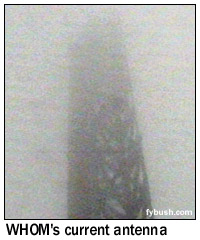 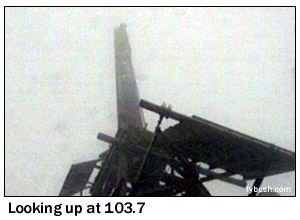 WMTW, assigned a
DTV allocation of channel 45, realized that a UHF signal from
Mount Washington would be unlikely to put a viewable DTV product
over Portland, its primary market. WMTW, assigned a
DTV allocation of channel 45, realized that a UHF signal from
Mount Washington would be unlikely to put a viewable DTV product
over Portland, its primary market.
(The advent of cable and satellite television had cut significantly
into WMTW's off-air viewership in the sparsely populated regions
north and west of the mountain; by the eighties, channel 8 had
moved its studio from Poland Spring to Auburn - and later to
downtown Portland itself - and was solely focused on southern
Maine.)
In 2001, WMTW built a new 1670-foot tower in the town of Baldwin,
Maine, on the west side of Sebago Lake and just a few miles from
the existing towers of Portland competitors WCSH-TV (Channel
6) and WGME (Channel 13), and on February 5, 2002, channel 8
signed off from the Mount Washington site and began transmitting
from the state of Maine for the first time in its nearly half-century
history. Soon, WMTW-DT will begin its own operations from the
Baldwin tower. (Weather permitting, we hope to present this tower
as next week's Site of the Week.)
(The weather did permit, sort of; you can see those pictures
here.)
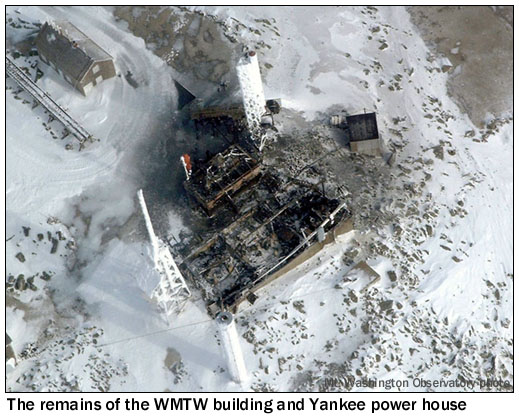 What next for Mount
Washington? There's pressure from Dartmouth University, which
controls the mountaintop, to clear off some of the development
that now greets hikers, drivers and those arriving on the historic
Mount Washington Cog Railway. It's not clear who will provide
power and maintenance for the radio stations and the Observatory
in the absence of WMTW. And it's certain that Maine viewers won't
hear Marty telling them about the nasty mountaintop weather any
more. What next for Mount
Washington? There's pressure from Dartmouth University, which
controls the mountaintop, to clear off some of the development
that now greets hikers, drivers and those arriving on the historic
Mount Washington Cog Railway. It's not clear who will provide
power and maintenance for the radio stations and the Observatory
in the absence of WMTW. And it's certain that Maine viewers won't
hear Marty telling them about the nasty mountaintop weather any
more.
(In a way, you could say that the university got its wish;
it's unlikely that the WMTW building and the Yankee Power House
will be replaced by anything nearly as large as those buildings
were. WHOM will likely relocate its transmitter to the Yankee
Building once it resumes broadcasts from the mountaintop; the
Yankee Building will probably also house some of the microwave
facilities, including the link from the Portland studio to the
Rumford transmitter of WLOB-FM 96.3, that remained behind in
the WMTW building.
As for the power supply on the mountain, the fire has already
renewed talk of a permanent power line to the summit, perhaps
via conduit attached to the Cog Railway tracks. If another generator
facility is constructed where WMTW's plant stood, connected to
the kerosene tanks - remember, diesel fuel would freeze at summit
temperatures! - that survived the blaze, it's sure to be much
smaller than the WMTW building was. And it's likely that at least
some of the towers at the summit will now come down. In the image
seen here, courtesy of the Mt.
Washington Observatory, the main WMTW tower is seen at bottom
center, with the Armstrong tower just above it. You can see the
red radomes of the WHOM auxiliary antenna above the charred remains
of the Power House; note that the bottom radome and part of the
middle one are gone. The main WHOM antenna is at top center and
seems to have survived. The generators were in the part of the
WMTW building at the right of the image.)
Progress marches on, we suppose; certainly WMTW today is more
interested in touting its "new, stronger signal" from
Baldwin than in its long history atop Mount Washington. But we
hope, years from now, that someone will still remember all the
long winters and hard work that went into the transmission of
television from this mountaintop.
The More You Know...For much, much
more detail on the early years of FM and TV on the Rock, don't
miss the "Articles" section of Norm Gagnon's outstanding
GGN Information Systems
site. Norm also features several early photos of the FM installations
on Mount Washington. Additional details on the Armstrong/Yankee
years on the mountain provided by Granite and Ether: A Chronicle
of New Hampshire Broadcasting by Ed Brouder (Bedford, N.H.:
NH Association of Broadcasters, 1993).
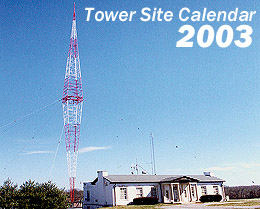 Want to see more neat sticks all year
round? Nashville's WSM (at right) is one of the more than
a dozen Tower Site images featured in the 2003 Tower Site Calendar,
coming this fall from Tower Site of the Week and fybush.com. Want to see more neat sticks all year
round? Nashville's WSM (at right) is one of the more than
a dozen Tower Site images featured in the 2003 Tower Site Calendar,
coming this fall from Tower Site of the Week and fybush.com.
If you liked last year's edition, you'll love this one: higher-quality
images (in addition to WSM, this year's edition includes Providence's
WHJJ; Mount Mansfield, Vermont; Buffalo's WBEN; KOMA in Oklahoma
City; WTIC, Hartford; Brookmans Park, England; WPAT, Paterson;
Four Times Square, New York; WIBC in Indianapolis; WWVA in Wheeling,
W.V.; WGN Chicago and more), more dates in radio history, a convenient
hole for hanging - and we'll even make sure all the dates fall
on the right days!
This year's edition is back from the printer, and shipping
is underway. Orders placed now will be shipped within 24 hours!
And this year, you can order with your Visa, MasterCard,
Discover or American Express by using the handy link below!
Better yet, here's an incentive to make your 2003 NERW/Site
of the Week subscription pledge a little early: support NERW/fybush.com
at the $60 level or higher, and you'll get this lovely calendar
for free! How can you go wrong? (Click here
to visit our Support page, where you can make your NERW contribution
with a major credit card...)
You can also order by mail; just send a check for $16
per calendar (NYS residents add 8% sales tax), shipping included,
to Scott Fybush, 92 Bonnie Brae Ave., Rochester
NY 14618.
Thanks for your support!
|